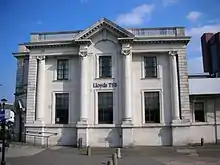P. B. Chatwin
Philip Boughton Chatwin (1873 – 17 December 1964)[1] was an architect in Birmingham, England.[2]
Early life and education
A son of the architect J. A. Chatwin, he was educated at the University of Birmingham, taking an MA,[3] and qualified as an architect, becoming FRIBA.[4][5][6]
Career
Having been articled to his father and to E. W. Mountford, of Lower Regent Street, London,[7] and studied design under William Bidlake at the Birmingham School of Art,[8] from 1866 he worked with his father, and in 1897 became a partner in the firm, J. A. Chatwin & Son. From 1936, Philip's nephew Anthony Chatwin was his partner in the business. The repair of churches was a speciality.[9]
An enthusiastic archaeologist and local historian, he was also a Fellow of the Society of Antiquaries. After his death, the Birmingham Archaeological Society recorded that it had lost "the last and one of the most active and distinguished of its founder members", and that he had "for the greater part of this century, embodied the history and antiquities of the County of Warwickshire".[10][11][12] He was appointed OBE in 1953, for archaeological services to the Ministry of Works.[13]
He was author of The Medieval Patterned Tiles of Warwickshire (1940) and editor of The Records of King Edward's School, Birmingham (1948).
Personal life
In 1906, Chatwin married Cecily Frances (1882-1968), daughter of chartered surveyor and land agent Robert Edward Couchman, of Birmingham, of a gentry family of Solihull They had no children.[14]
Works
- All Souls' Church, Witton (consecrated 1907).[15]
- King Edward VI Handsworth girls' school (opened 1911).
- St Mary, Moseley (nave and south aisle rebuilt 1910; repaired war damage 1952-54), Grade II listed[16]
- St Mary the Virgin, Acocks Green Church and Church Hall, Acocks Green (opened c. 1908)
- Lloyds Bank, New Street, Birmingham (1914), Five Ways, Birmingham (1908-9), Leicester (1903)
- St. Faith and St. Laurence's Church, Harborne 1936-37
- Queen Alexandra Kindergarten for the Blind, Harborne, Birmingham Royal Institution for the Blind
References
- Pevsner Architectural Guides - Birmingham, Andy Foster, 2005, ISBN 0-300-10731-5
- Transactions of the Birmingham and Warwickshire Archaeological Society, vol. 81, 1966, p. 13
- Essays in honour of Philip B. Chatwin. Birmingham Archaeological Society, Birmingham, Eng, Dugdale Society. V. Ridler. Birmingham University Press, 1962
- The University of Birmingham Calendar 1967, University of Birmingham, 1967, p. 150
- Ministers' Accounts of the Collegiate Church of St Mary, Warwick 1432-85, Dorothy Styles, Collegiate Church of Saint Mary the Virgin, 1969, p. vi "Memoir of Philip Boughton Chatwin, O.B.E., M.A., F.S.A., F.R.I.B.A."
- Who's Who in Architecture, ed. Frederick Chatterton, Architectural Press, 1923, p. 52
- Edwardian Architecture: A Biographical Dictionary, A. S. Gray, University of Iowa Press, 1986, p. 141
- Who's Who in Architecture, ed. Frederick Chatterton, Architectural Press, 1923, p. 52
- Birmingham Archaeological Society Transactions and Proceedings, Birmingham Archaeological Society, 1960, p. 3
- Birmingham's Victorian and Edwardian Architects, Phillada Ballard, Birmingham and West Midlands Group of the Victorian Society, 2009, p. 115
- https://discovery.nationalarchives.gov.uk/details/c/F30414
- Ministers' Accounts of the Collegiate Church of St Mary, Warwick 1432-85, Dorothy Styles, Collegiate Church of Saint Mary the Virgin, 1969, p. vi "Memoir of Philip Boughton Chatwin, O.B.E., M.A., F.S.A., F.R.I.B.A."
- Essays in honour of Philip B. Chatwin. Birmingham Archaeological Society, Birmingham, Eng, Dugdale Society. V. Ridler. Birmingham University Press, 1962, p. 1
- Supplement to the London Gazette, 1 June, 1953, p. 2957 URL= https://www.thegazette.co.uk/London/issue/39863/supplement/2957/data.pdf
- Burke's Landed Gentry, 17th edition, ed. L. G. Pine, Burke's Peerage Ltd, 1952, Couchman of Solihull
- The Buildings of England. Warwickshire. Nikolaus Pevsner. Penguin Books. ISBN 0140710310 p.211
- Historic England. "St Mary, Moseley (1076209)". National Heritage List for England. Retrieved 13 July 2006.
- Who's Who in Architecture, ed. Frederick Chatterton, Architectural Press, 1923, p. 52
